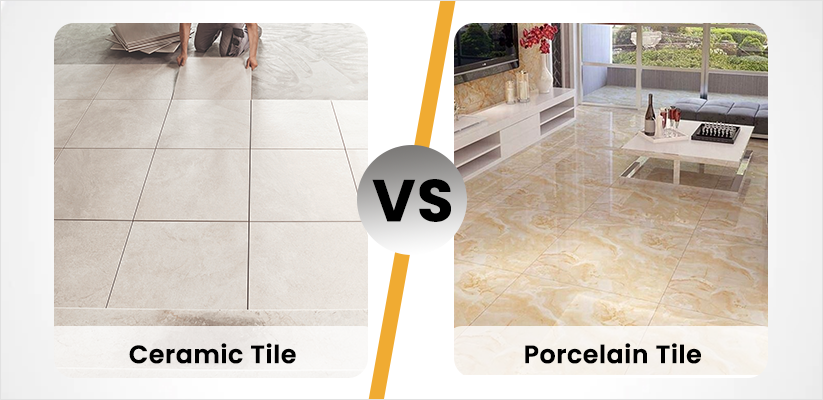The Difference Between Ceramic and Porcelain Tiles: Tile is one of the oldest and more versatile floor and wall coverings around. You can find tile made of clay that has lasted hundreds of years and also new tiles being produced today.
Some people will use the terms ‘porcelain’ and ‘ceramic’ tiles interchangeably, but there are a few differences. Despite the fact that both are man-made and created from clay, they are very different materials in looks, durability, and how they are created. We outline the differences between the two below so that you can make a better decision about which to use in your next project.
Porcelain vs. Ceramic
After having read the today’s article, you would be able to tell the difference between porcelain and ceramic tiles. But if there were still confusion, we will be more than happy to help. You can always contact us here and if you need to know more about us, you can read here.
Construction
Ceramic tiles are made using natural red, brown or white clay. First the clay is fired at a high temperature to reduce the water content, the glaze followed by the pattern is then applied. Voila, then you have your finished product.
Porcelain tiles are made using very specific clay, with finely-ground sand and feldspar added to the mixture. The tiles are fired at a higher temperature than ceramic, this helps to make porcelain tiles super hardwearing.
Cost
They both have a wide range of costs, but generally, Ceramic tiles tend to be more cost effective than porcelain.
Density & Durability
Porcelain tiles are denser than ceramic, and therefore less porous. Meaning they’re harder, therefore more durable and absorb less water. This makes them more suited to high footfall areas which will see heavy use.
This doesn’t mean that ceramic is not as good however! As it’s less dense, it’s also less brittle and it’s an easier to work with. To you DIYers out there, make life a little easier for yourself and use ceramic.
Ceramic and Porcelain PEI Qualities
The construction and qualities of ceramic and porcelain tiles differ greatly.
One classification that affects where to use specific ceramic and porcelain tiles is called the Abrasion Resistance Porcelain Enamel Institute (PEI) Rating. The rating ranges from 1-5, with 5 being the toughest and 1 being not as durable.
Most ceramic floor tiles are graded between 3 and 4. Porcelain tiles tend to have a rating between 3 and 5.
Appearance
Ceramic tiles come in far more colors and sizes than porcelain, ranging from ⅜-inch mosaic to 16-inch or larger tiles. Even there are more Ceramic tile floor patterns than porcelain. Porcelain comes in mosaics but usually starts at 2 inches in size, skips up to 6 or 8 inches, then 12 inches. It may eventually reach square sizes of 36 or 48 inches.
Contemporary porcelain tiles may have a wide range of styles, including those that are made to look like wood, fabric, glass, metal, and stone. Ceramic tiles may mimic the look of stone for some floor tiles but generally look like what they are, which is glazed clay tiles.
Installation
Ceramic and porcelain tiles are installed similarly. The biggest difference is that large format porcelain requires extra steps to ensure that it is level. Ceramic tiles, which tend to be smaller, do not require these extra steps.
For tiles 12 inches or smaller, the installation process is the same. A dry fit, or layout of the tiles, is done to blend color and check for fit. The tiles are cut to size. For ceramic tile, this may mean scoring and snapping the tiles for wall tiles or using a wet saw for floor tiles. Porcelain tile must always be cut using a wet saw, usually with a diamond blade.
Fire Resistance
Both ceramic and porcelain tile are flame-retardant. Both were produced in extremely high temperatures and can withstand heat without issue. Neither will burn or ignite nor spread flames.
Stains
Both ceramic and porcelain are fairly stain-resistant. Porcelain will always be stain-resistant, however, because the material is non-porous.
Ceramic tile may stain if the glaze on its surface crazes or cracks over time or if you purchased a crazed wall tile.

Allergens
Both porcelain and ceramic tile are considered allergen-friendly materials. Each has a hard, non-porous surface that does not hold dust, pollen, or other allergens.
Outdoors
In areas without a freeze-thaw cycle, porcelain tile may be used outdoors without issue. It may even be appropriate in areas with freeze-thaw cycles, but if the tile absorbs any moisture, it could be damaged in a frost heave or deep freeze.
Ceramic tile should never be used outdoors, even in moderate or warm climates, as the material cannot handle the elements.

Water Absorption Rate
Ceramic tile may be classified as having one of several different water absorption rates:
- Non-vitreous, meaning it can absorb more than 7% water
- Semi-vitreous, meaning it can absorb between 3% and 7% water
- Vitreous, meaning it can absorb only 0.5% water
Porcelain tile, however, is considered impervious, meaning that it absorbs less than 0.5%. In normal, everyday use, most ceramic tile will not be affected by its absorption rating because it has a glaze covering its clay body.
However, if you use ceramic tile in a steam shower, or if you purchase tile with a crackled or crazed finish, it is best to purchase vitreous tile to prevent staining. Porcelain tile can be used anywhere due to its low absorption rate.
How to Tell the Difference between Ceramic and Porcelain Tiles?
The easiest and fastest way to tell a ceramic tile from a porcelain tile is to take a look at its edge. the color in porcelain tiles goes all the way through the tile.
If you chip a ceramic tile, the glaze will come off, and the clay body will be exposed. But If you chip a porcelain tile, no change in color occurs.
However, the bottom line is you can’t go wrong either way. Both ceramic and porcelain tiles come in a range of costs to suit all budgets, both durable, hardwearing and a superb material to create the perfect look.
You just need to specify the place, the traffic and the use of it and then choose which one suits you best.

Summery
Porcelain Vs Ceramic
The major difference between porcelain tile and ceramic tile is how it’s made. Both tiles are made from a clay mixture that’s fired in a kiln, but porcelain tile is made from more refined clay and it’s fired at higher temperatures. This makes it denser and more durable than ceramic tile. That’s why porcelain tile is more expensive than ceramic tile and generally considered to be of higher quality as well.
The other main difference between a porcelain and ceramic tile is the rate of water they absorb. Porcelain tiles absorb less than 0.5% of water whilst ceramic and other non-porcelain tiles will absorb more. This is down to the stuff used to make porcelain tiles. The clay is denser and so less porous. It effects how the tiles behave, and what they’re best used for.
Etminan Ceramic Tiles Manufacturing(www.etminan.ae)
For see our products visit: Products




2 Comments. Leave new
[…] Read more about: The difference between ceramic and porcelain tiles […]
[…] Also read this article: The-Difference-Between-Ceramic-And-Porcelain-Tiles […]